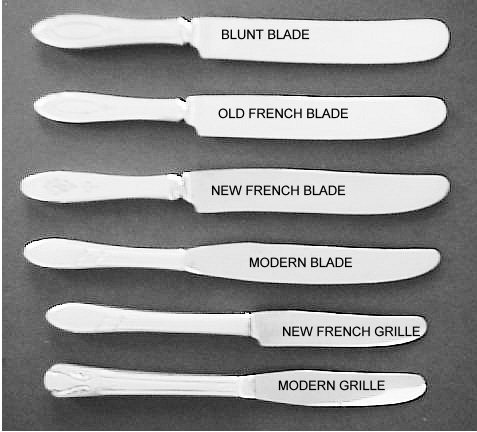IDENTIFICATION & CARE OF SILVER
IDENTIFICATION - IS IT STERLING OR SILVERPLATE AND WHAT IS THE PATTERN NAME?
How do you identify your silver? Is it sterling or silverplate? If you are lucky, you remember the pattern name and you can look up the pattern and determine if it is sterling or silverplate. Sterling silver is defined as 92.5% silver and 7.5% alloy (usually copper). About 1895 American manufacturers were required to mark their sterling silver items with the words "Sterling". Before this requirement, some items were marked and others were not. Some older (before 1890's) silver was marked 925 to indicate 92.5% silver content.
Coin silver is usually (but not always) of less purity than Sterling. Modern silverware from an American manufacturer should be considered sterling only if it says "STERLING" on the back of the item. Otherwise it is generally silverplate, coin, stainless or an alloy such as German silver. German silver is an alloy (mixture of metals) containing no silver. Words such as International Silver, xxx Silver Co., A+, 1847 Rogers, etc., do not designate sterling. Words such as International Silver, xxx Silver Co., A+, 1847 Rogers, etc., do not designate sterling.
Obtain a copy of "Sterling Flatware" or "Silverplate Flatware" by Tere Hagan from your library, local antique dealer or bookstore. These excellent references will provide you with pictures and information on identifying your pattern.
If you can not find Tere Hagan's books (or similar), send us (mail or e-mail) an image or photocopy of the pattern and we will try to identify it for you. Be sure to include any identifying names or other marks on the back of the item. American silverware (sterling and silverplate) is identified by a pattern name and a manufacturer. A manufacturer usually has many patterns of silver. Occasionally an item will have its pattern name on the back, however it is more common to find the manufacturer's name on the back. Therefore the name on the back (Rogers, 1847 Rogers or Gorham), while important, does not tell you the pattern. Also you may be able to identify the pattern by comparing it to the silver images available on the web or in the Tere Hagan books.
Silver items from foreign countries are usually marked by various hallmarks to identify country and city of origin, silver content, maker, and year of production. There are many references, including the web, for identifying hallmarks.
CLEANING
We recommend hand washing silver in warm sudsy water, being very careful to remove all food particles. Rinse thoroughly and wipe dry with a soft clean cloth. If the silver needs polishing, hand polish with a soft damp rag using Wright's silver polish or similar polish. Wright's polish can be obtained from any grocery store. After polishing, carefully clean with warm sudsy water, rinse and dry with a soft cloth. Hand polishing and washing will leave the natural patina (oxidation) in the detail of the silver pattern.
We strongly discourage cleaning silver in a dishwasher or using dip type cleaners. Dishwashing can expose the silverware to extreme temperatures that can loosen handles, and scratches can occur from the utensils rubbing together in the dishwasher. Dipping, while very easy and quick, removes tarnish along with all patina from the silver leaving a flat, featureless piece of metal with no character in the pattern. Dipped flatware may need additional polishing (a very labor intensive process) to bring back the beautiful luster we associate with silver.
CARE AND STORAGE
We encourage you to use your silver. Use and frequent washing with warm sudsy water help to maintain the beauty of the silver. This will also reduce the amount of polishing required.
When you store your silver, place it in a dry location with minimal air circulation. A dry area with little air circulation will minimize the amount of oxidation of the silver. This will greatly reduce the polishing required to maintain the beauty of the silver. A tightly closed silver chest or a similar container is an excellent place to store the silver. Several pieces of school chalk (any color!) placed in the storage chest also helps absorb oxidizing gases. Another easy method of storage is to carefully roll the silver pieces in a soft towel or cloth and neatly store.
Do not use plastic wrap such as Saran wrap, tape or rubber bands to wrap silver pieces together. These materials can chemically react with the silver and can cause stains that are extremely difficult to remove.
BLADE TYPES
Flatware knives were made in a variety of styles, lengths, and materials. If an exact match of style and type is needed, it is important to identify the knife blade you wish to order. Knife styles, lengths and blade materials often varied by manufacturer and year. The most common luncheon and dinner knife blade types are blunt, old French, new French, and modern. Grille (viande) knives can be new French or modern blade. Each of these are shown in the image below.
Blade materials may be silverplate or stainless steel and rarely sterling silver. Silverplate blades may be found on older sterling and silverplate patterns. Stainless steel blades are typical of more modern patterns. Sometimes older knives have had worn-out silverplate blades replaced with stainless blades. New French and modern blades are almost always stainless steel. This is usually stamped on the blade.
To help you identify the exact knife you have, please refer to the image below showing the 6 most common blade styles for dinner,luncheon and grille knives. If in doubt about the type of blade that you have do not hesitate to email us for additional information.
The blades shown are typical blade styles. Actual knife and blade length will depend upon the particular pattern. We hope you can use this information.
